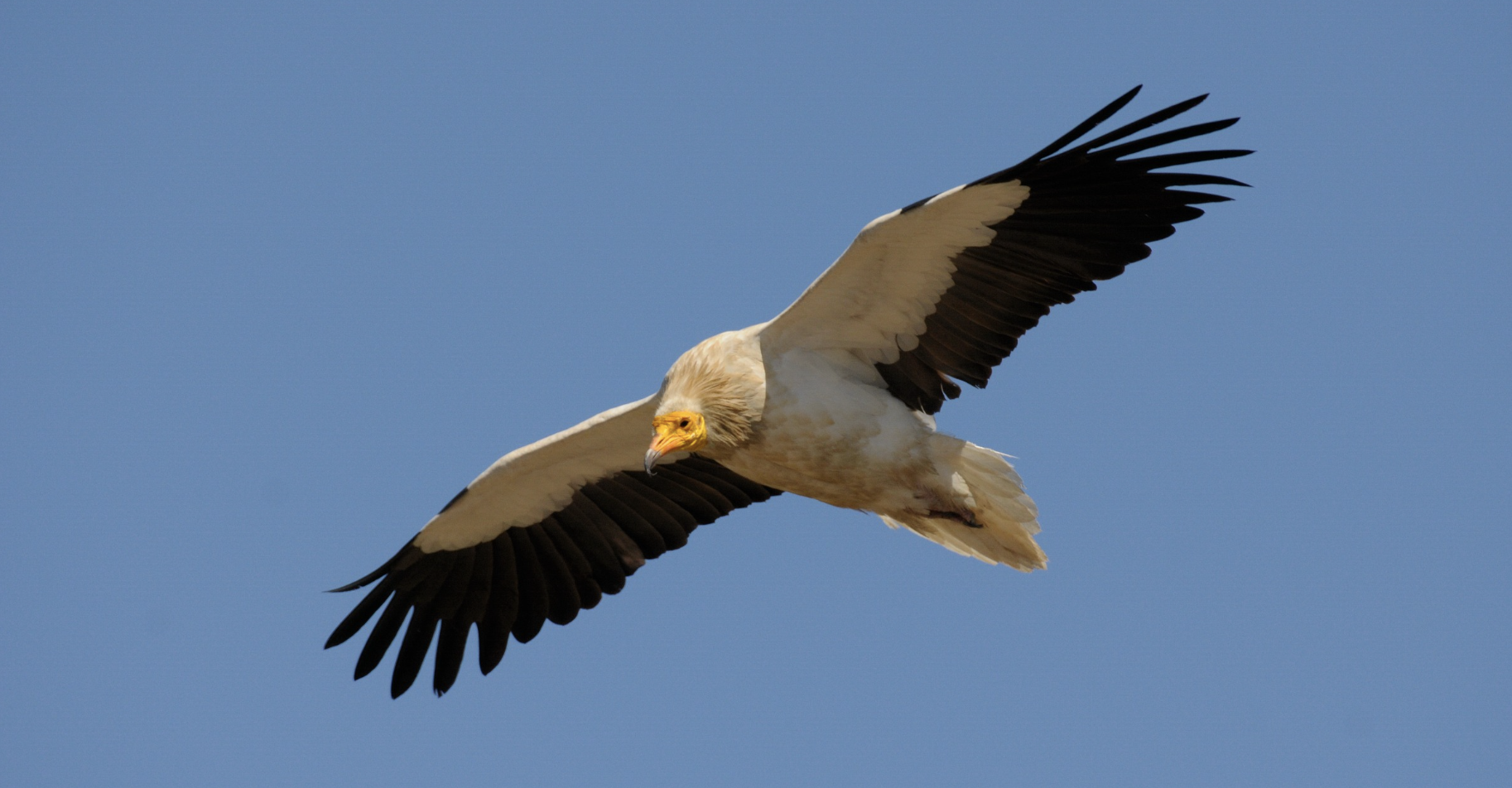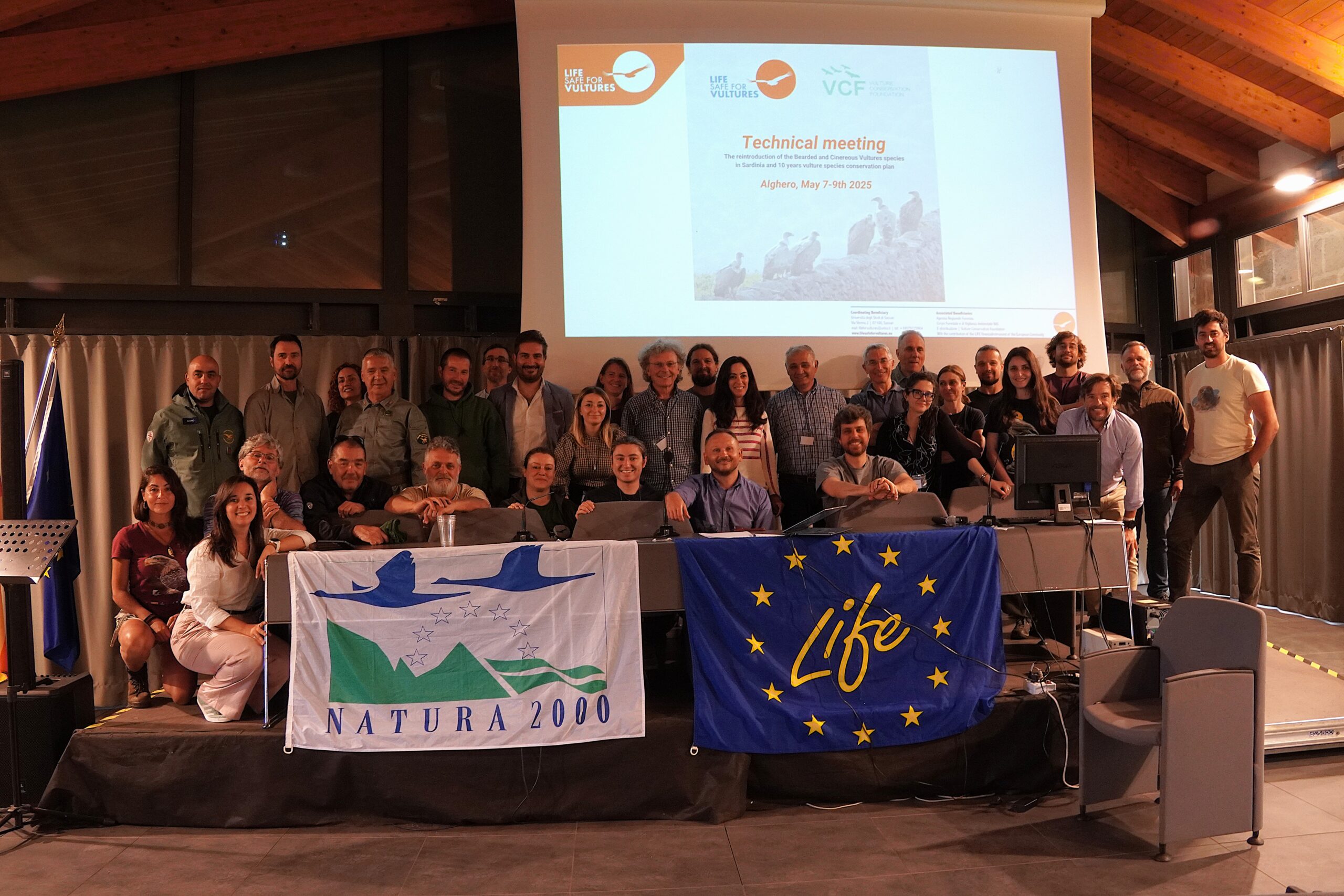
The migration of Europe’s only migratory vulture, the Egyptian vulture, is nearing completion as the Egyptian vultures that breed in Europe arrive to their wintering grounds in sub-Saharan Africa. This week we’ll be sharing the travels of some birds from two conservation projects we’re involved in, the LIFE Rupis on the western flyway and the Egyptian Vulture New LIFE, on the eastern flyway making their way on this epic journey.
Crossing continents
Each year, at the end breeding season, between August and September, Egyptian vultures leave Europe and head to their wintering grounds in sub-Saharan Africa. The journey for Iberian birds is around 3,300km.
In Europe the majority of the population in of Egyptian vultures are found on the Iberian Peninsula and primarily Spain, an estimated 1,300 – 1,500 pairs. Nearly all of the birds on the Iberian Peninsula will cross to Africa through the Straits of Gibraltar, a migratory bottleneck, along with many hundreds of thousands of other migratory birds in what makes up the western flyway of the African-Eurasian Flyway. Once in Morocco they tend to follow slightly different routes across the Atlas Mountains into the Sahara desert, but many of the Iberian Egyptian vultures eventually converge again in countries such as Mali and Mauritania, as they gather across savannah habitats in their wintering grounds.
Following Egyptian vultures

As part of efforts to understand their movements in the breeding areas as well as along the migration route five wild adult birds were fitted with small GPS transmitters in the Douro Canyon region in 2016 and 2017, as part of the LIFE Rupis project. Now, two of the three tagged birds that are are still transmitting, have reached the wintering grounds after another harrowing migration.
Rupis and Douro
Douro, an adult bird, was caught and fitted with a transmitter at the Escalhão supplementary feeding site in 2017, after a successful breeding season in the Douro Canyon region this year began their migration first heading south on August 29. The subadult male Rupis, the first bird to be caught and tagged in the project in 2016, however, left later than Douro, leaving on September 22. Both birds stopped for several days at Caceres, Extremadura in Spain, a site with plentiful food and also where the non-migratory population of Egyptian vultures spend their winters.

They both crossed the strait of Gibraltar without any problems, and then moved quickly south through Morocco, but as they cross the Sahara Desert, their signal disappeared due to no telephone GSM cover. After a tense wait, both finally reappeared on the Mauritania-Mali border, about 2,500 km from their breeding grounds – Douro reappeared on the 10th October, while Rupis did so on the 19th, quite nearby.
Both will will now spend the next months in Africa until they migrate up in March or April.
Faia
Caught and tagged last year Faia left their summer range on August 31 and headed south heading to the Strait of Gibraltar. Due to bad weather they were forced to wait until it was clear enough to cross along with thousands of other raptors and storks.

But we’ve not had any data transmitted from Faia’s GPS transmitter since the beginning September 6 where they were last seen in northern Algeria. As with Douro and Rupis we’ll wait until they reemerge to an area with telephone GSM coverage and find out where they traveled.
You can follow the live movements of all these birds on the Monitoring page of our website.
Feeding stations

As part of the LIFE Rupis project the team have set up a series of supplementary feeding stations which are turning to be very important for Egyptian vultures in the Douro valley, particularly in the period before migration. –Our colleagues from Associação Transumância e Natureza (ATN) spotted a record number of 22 different Egyptian vultures feeding together in the Escalhão supplementary feeding site. These are also important for other scavenger species, with cinereous vultures feeding there regularly, and a rare immature imperial eagle also coming down to feed last September– the species is only common in southern Iberia.
LIFE Rupis
The LIFE Rupis conservation project, led by Portuguese wildlife organisation Sociedade Portuguesa para o Estudo das Aves (SPEA), and funded by the European Union’s LIFE Fund and the MAVA Foundation, is working in the cross-border Douro region of Spain and Portugal to protect and strengthen the populations of Egyptian vultures and Bonelli´s eagle. With around 135 breeding pairs, the region has one of the largest population of Egyptian vultures in Europe. Creating a network of feeding stations, improving habitat and nesting sites as well as tackling the major threats of electrocution from electricity pylons and illegal wildlife poisoning, the LIFE Rupis project will strengthen the population and improve breeding rates.
The LIFE RUPIS project is implemented by the VCF and partners, including SPEA (BirdLife in Portugal), ATN and Palombar (regional conservation organisations in NE Portugal), the Junta de Castilla y Leon & the Fundación Patrimonio Natural de Castilla Y León, the Portuguese electricity distributor EDP-D, the Portuguese statutory conservation agency ICNF and the Portuguese environmental police force (GNR), and is co-funded by the MAVA Foundation.
For our next post we’ll head to the Balkan Peninsula and catch-up with the migration of birds released as part of an experiment to test different release techniques of captive-bred Egyptian vultures.






